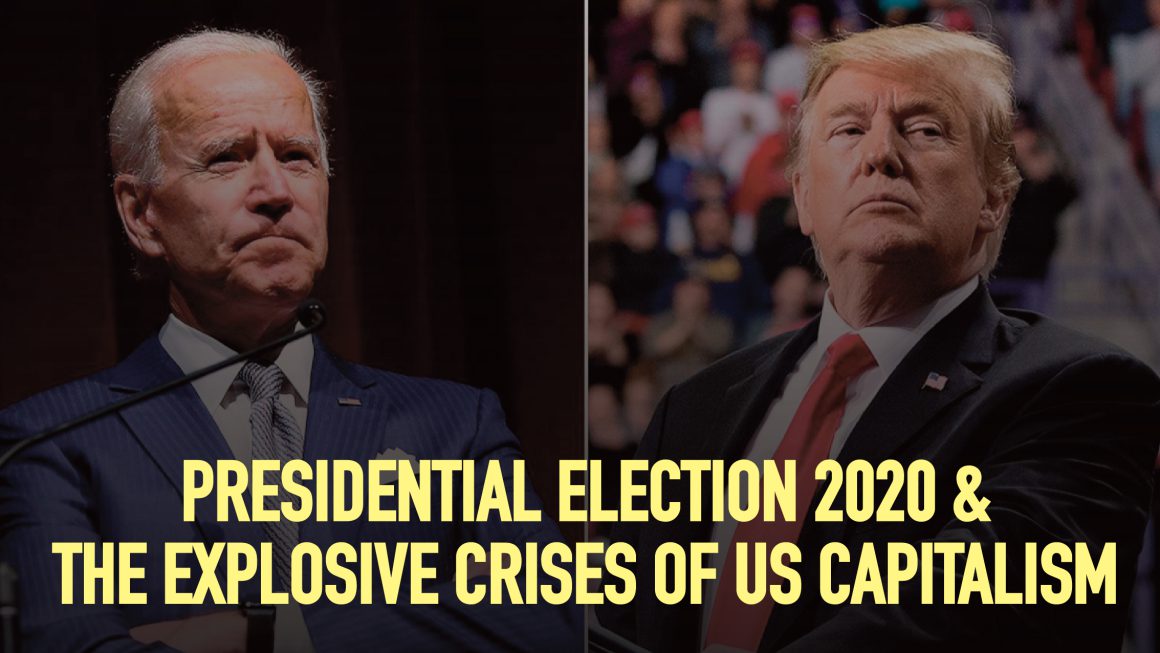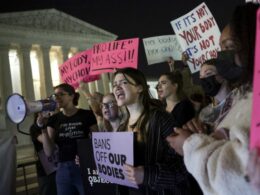By Harper Cleves
2020 has been a year characterised by an extreme crisis of capitalism, seen most clearly through the deadly COVID-19 pandemic and the global recession. In a year marked by upheaval, this US presidential election seems out of step; featuring a standoff between one of the least popular modern US presidents Donald Trump and yet another lacklustre Democratic Party candidate, Joe Biden. The eventual results of this election will inevitably have repercussions on consciousness and political activity globally, as we saw this summer with the black lives matter protests. As such, it is essential that we have a clear understanding of the different dynamics at play so we can prepare for the struggles that emerge in the future.
COVID-19 and the Greater Depression
Before analysing the details of the election itself, it is important to situate this presidential race in its context. Even before COVID-19, the global economy was teetering on the brink of disaster, reflecting the crisis-ridden nature of capitalism. The constant competitive thrust of the market led to years of neoliberal attacks on social protections, an overreliance on debt and increasing protectionist policies flowing from the US-China trade war. COVID-19 and the subsequent closing of economies worldwide tipped the scales and triggered a recession that was already impending.
The impact of this recession on the American economy and the American working class in particular has been substantial. Following the end of the second quarter of the year (May – June) the average rate of decline in GDP at that stage was 31.7% with predictions for the total decline of the year ranging from a 46% decline in real (inflation adjusted) GDP to a more conservative 36% decline.
With the third quarter nearly ending, and the economy continuing to open up, the rate of decline has dropped moderately to 31.4% indicating a certain amount of recovery, which is predicted to continue to a certain extent as more businesses open up and more people are able to return to work. Trump and his supporters often point to the 10.6 million jobs which have been created since the beginning of May as further evidence of recovery, and Trump’s leadership and decision making skills over the course of a pandemic.
Of course, these statistics do not tell the whole story. Some economists are describing the current recovery in the US economy as K shaped; meaning the people in the higher income brackets (the capitalist class and upper middle class) are faring better financially than they did before the pandemic while the vast majority of Americans are treading water, if not already drowning. While official unemployment figures have dropped as the economy has opened up, these numbers do not account for the 20.5 million workers who want to work but cannot, the 7.5 million in part time work or the 1.4 million who file for unemployment benefits each week. An estimated 27% of American adults did not pay their rent or mortgages for the month of July. For Black Americans 31% of renters were unable to pay their rent last month compared to 28% for Latinos and 14% for white renters, demonstrating the racialised legacy of generational wealth in the US. Meanwhile US billionaires have increased their wealth by 29% over the pandemic, accumulating roughly $845 billion since the beginning of the lockdown.
These figures alone demonstrate the tremendous precarity of most working class people living in the United States as well as the disgusting wealth inequality that has been exacerbated by this crisis. And yet none of these figures take into account the huge scale of tragedy as a result of Trump’s reckless approach to pandemic precautions. At the time of writing, 220,000 Americans have died as a result of COVID-19 and 7.75 million have contracted the disease. This number is projected to double to 410,000 before the year ends; a number which exceeds the amount of Americans killed during World War II.
Climate Crisis
On top of the COVID-19 crisis and the recession the US is also being hit by the climate crisis which for many people calls into question the very existence of humanity. This year has seen some of the hottest heat waves, historic fires and one of the most active hurricane seasons on record. Millions have been evacuated and hundreds of thousands have lost their homes to raging wildfires and flooding. In the middle of a pandemic characterized by respiratory complications, millions in the Western United States have been forced in doors due to dangerous air quality.
This occurs on the back of a wave of global youth protests in 2018 and 2019 on the issue of climate and widespread popularity for system change and not climate change and it has not gone unnoticed for many young people that the wildly popular green new deal championed by Bernie Sanders and AOC has not been adopted by either presidential candidate.
Black Lives Matter
This backdrop of extreme precarity for working class Americans, and especially for people of colour living in the United States set the stage for the explosive black lives matter protests that re emerged in June of this year. According to the Center for Disease Control Black people living in the United States are 2.6 times more likely than white Americans to contract COVID-19, are 4.7 times more likely to be hospitalized as a result of the disease and are 2.1 times more likely to die. In a study conducted early in the year, black teenagers were asked to answer specific questions about how often they experience different forms of overt and subtle racism on a fortnightly basis. Those surveyed experienced an average of five comments of a charged racial nature a day. All of these factors, including previously cited statistics on housing precarity and unemployment combined with a legacy of racist policing to create an explosive situation following the racist police murder of George Floyd.
The support for these protests, while it has decreased 67% to 55% since June remains significant. Over the course of June, support for the black lives matter movement increased by 26 points, as much as it had in the entire two years previous and slogans around defunding the police became popularised with an average of 31% of Americans showing some support for the idea. Much of this support was likely consolidated following the National Guard presence in various protesting cities and the use of unmarked government vans to round up protesters throughout the summer protests.
Workers’ Struggles
All of this unrest has also found it’s expression in worker struggle, including important examples of struggle by unorganised and precarious workers. Since the beginning of March, a Labor News website called PayDay Report has identified over 1,100 wildcat actions and 260 official strikes between 1 March and 31 May, and these numbers are expected to be underreported. Grocery workers, and Amazon warehouse workers took actions against workplace safety in the context of dangerous pandemic conditions. Bus drivers in New York and Minneapolis refused to transport Black Lives Matter protesters on behalf of police.
The US Postal Service faces attack by the Trump Administration and the American Federation of Teachers threatened to strike over unsafe school reopenings. This follows recent militancy demonstrated by teachers in places ranging from Los Angeles to West Virginia. In the past couple of years women workers in places ranging from McDonald’s to Google put the issue of sexual misconduct and assault at the center of workplace issues through walkouts.
Polarised Consciousness
A tremendous amount of potential exists for socialists looking to organise in this period. In the context of a Bernie Sanders primary race, 70% of millennials said they would vote for a socialist for president. 22% of Millennials also said that the country would be better if private property was abolished. Furthermore, in a recent Pew Research poll 65% of Americans say the rich are rich because of ‘advantages in life’ rather than inherent skill, compared to 42% in 2018. Between pandemic inequality, climate change, and racist police brutality, more and more people are drawing systemic conclusions and looking for alternatives. More and more people are looking for ways to fight back. The potential for socialists to organise in this context is tremendous.
Of course, another aspect of American consciousness is the right wing sentiment that characterizes Trump’s base, and which at this moment in time seems to coalesce around the rhetoric of conspiracy theories including anti-mask ideas and Q-anon. Generally, American consciousness during this period of time is moving to the left, with young people, women, and people of colour leading the way. However, at the same time the right wing core is being consolidated and moving further to the right, reflecting a process of polarisation taking. This is the context in which the elections in November are taking place.
The Election: can Trump win?
As of right now, the prospects for a Trump re-election do not look promising. Biden is now ahead by 10.2% in national polls. He is also ahead in six out of eight key swing states which will potentially determine the election. Trump is running a campaign low on substance, that plays on working people’s suspicions of the elite and fear of economic precarity at one end, and assures the super rich of their secure position in society at the other. One of Trump’s lines of attack is the absurd claim that corporate politician Biden is a ‘puppet of the radical left’ alluding to a Biden, Sanders agenda, and claiming that Biden would be an asset to the Communist Party of China. However, it doesn’t seem to be working in the same way that Trump’s attacks on Clinton as a member of the political establishment did.
Furthermore, Trump’s poor performance in the presidential debates in which he failed to renounce white supremacy and appeared to bolster the far right, neo-fascist group the Proud Boys was not received well by many American voters. Soon after the debate he contracted COVID-19, initiating an outbreak in the White House that eclipsed the number of total cases in small countries like New Zealand.In one poll 67% of saw Trump contracting Coronavirus as being a direct result of him not taking the deadly disease seriously enough, an issue that will be central on many voters minds come Election Day.
And yet we shouldn’t discount a Trump victory. This is in part because of the undemocratic electoral college system and Republican voter suppression tactics which target in particular people of colour and young people.
However, the main reason we cannot discount a Trump victory is because of the nature of the Democratic Party itself. In a Reuters Poll conducted at the beginning of the year (before COVID-19) 64% strongly or somewhat agreed with the statement that ‘the very rich should contribute an extra share of their wealth each year to support public programs.’ By contrast, Democrats have a long record of defending the interests of corporations and the rich. Democrats like Nancy Pelosi, previously lauded for superficial ‘clapbacks’ at Donald Trump has famously received nearly $200,000 from the fossil fuel industry in her 2018 campaign. She was chosen by the Democrats to sit on the Select Committee on the Climate Crisis. Furthermore Trump’s horrific approach to immigration, including caging young children separated from them at the border, was built on Obama’s legacy. Obama’s deportation numbers actually exceed those under Donald Trump. While there are of course tangible differences between Obama and Trump, and indeed Biden and Trump, most notably Trump’s often explicit support for white supremacists, the fact remains that the Democratic Party is no friend of the working class.
Can Biden lose?
Joe Biden as the preferred choice of candidate for the Democratic Party reflects these class allegiances, and thus is the reluctant choice of many Americans. In a poll conducted by the Pew Research Centre in 2016 nearly identical numbers of registered voters (33% in support of Trump, 32% in support of Clinton) cited their main reason for supporting their candidate as being that they were not the other candidate. Interestingly, in the same poll conducted in 2020 an overwhelming number of Biden supporters cite ‘not being Trump’ as the main reason for backing Biden. This demonstrates in particular two things: the polarization that exists in US society, and the weakness of Joe Biden as a candidate.
Biden is a candidate that has never generated the excitement of arguably one of the most politicised layers of society : the youth, who emphatically did not back him in the Democratic Party primaries. There are a number of reasons for this. Biden and Harris refuse to seriously take on the issue of climate change, opposing the Green New Deal and indeed openly supporting fracking in the wake of the debate will likely be a huge source of concern to many voters.
Furthermore, Biden has stated he would veto the medicare for all bill if it reached his desk in the oval office, a bill which has up to 67% support amongst American adults. Biden attempted to ameliorate his record on race, and his accusations of sexual assault by choosing Kamala Harris as his running mate. While it is true a certain layer of likely Democratic voters will have felt a sense of relief at the choice of a woman of colour as the Vice Presidential pick, many politically savvy young voters are also all to aware of her own abysmal record of policing in the context of widespread acceptance of police violence and support for police reform.
This is all to say, if Donald Trump wins the election, the blame will fall squarely on the shoulders of the Democratic Party establishment. The Democratic Party, for the second time running, was so desperate to cut across the organizing approach of Bernie Sanders that it threw its weight behind the first candidate that happened to beat Sanders in the primaries, Joe Biden. With a dynamic candidate with popular policies like Medicare for all, taxation of the rich, and free public college education this presidential race would look entirely different and the scales would almost definitely be tipped in opposition to Trump.
Harm Reduction: Will the lesser of two evils save us?
The harm reduction argument seems to be a very predominant reason many millennials and Generation Z voters are backing Joe Biden. Even while Joe Biden’s record makes many especially young people, women, and POC voters uneasy, the alternative of another four years of Trump is enough to generate a lacklustre support from many people. This has expressed itself most aptly in the ‘Settle for Biden’ slogan, which the candidate himself seems to be embracing.
Electorally, this term harm reduction implies taking a stance against racism, sexism, and state repression by choosing a candidate less likely to support damaging policy, or someone who is perceived to be more likely to be pushed left by public pressure. In practice this has expressed itself in supporting the Democratic candidate in opposition to the Republican candidate.
Given the horrific track record of Donald Trump, and the current state of affairs in the United States it is understandable why many people living in the United States who are open to socialist ideas and want systemic change will vote for Joe Biden.
Another concern many Americans are grappling with linked to the fear of being stripped of basic rights has to do with the recent death of Supreme Court Justice Ruth Bader Ginsburg and the subsequent precarity of constitutional abortion rights. This is a legitimate concern. Abortion rights in the US have long been on attack and are certainly at risk of being overturned by the current conservative court, which proved that even hard won gains made by the working class can be overturned by the capitalist system. However, abortion rights in the US were originally won under the conservative Nixon administration- not through the benevolence of the elite institutions but due to mass movements and struggle.
Furthermore the lesser evilism approach effectively endorses continuing to work in and around the Democratic Party and bolstering its ranks. This is a position even taken by other groups on the left. The Democratic Socialists of America (DSA) for instance have historically advocated working within the Democratic Party in an effort to push it in a more progressive direction, a position supported by the founder Michael Harrington. This perspective has largely been discredited by reality, considering the monumental efforts the Democratic Party establishment have utilized to prevent Bernie Sanders from getting the nomination. This seems to have been a shock to a certain layer of DSA thinkers, with a Jacobin article that triumphantly claimed the Democratic Party to be ‘Bernie’s Party’ following the Nevada primary victory.
Others in the left wing of DSA, including Bread and Roses Caucus theoretician Eric Blanc, have tried to straddle the line between an immediate break with the Democrats and a prolonged strategy of working alongside corporate backed Democratic politicians by advocating for a ‘dirty break’ with the Democratic Party.
This position advocates building and working within the Democratic Party now, winning away some of its bases of support in the process, with the eventual plan to break with the Democratic Party and the two-party system when enough support has been won. This plan assumes a fairly linear progression of consciousness, and fails to understand the precarious base of Democratic Party support. A recent poll has shown that 60% of adult voters want an alternative to a two party system. Furthermore, the Democratic Party apparatus is not democratic. The Democrats have developed an infrastructure to maintain capitalist control of the party, the introduction of Super Delegates to the Democratic National Convention acting as one clear example of that. The longer socialists and left activists spend their time working within a party that is designed to limit their success, the less likely they will be able to break from that party with any substantial success.
Furthermore this approach in practice looks not dissimilar to the approach taken by more conservative elements of the DSA. The Bread and Roses and Reform and Revolution caucuses advocate for a protest vote for Green Party Howie Hawkins in ‘safe states’ while advocating for a vote for Biden in ‘swing states.’ This approach does not fundamentally challenge the Democratic Party apparatus and is likely confusing for genuine DSA members looking for answers in a disappointing presidential field. Given the nature of the electoral system in the US, this essentially amounts to support for Biden, despite his horrendous record and policies, and a return to the dead end politics of the lesser evilism.
Socialist Alternative, the sister organisation of the Socialist Party in the United States, advocates for a vote for Howie Hawkins in all states. While the Green Party will not be the basis of creating a mass workers party, Howie Hawkins is a candidate with a programme to the left of Bernie Sanders. He advocates for Medicare for all, 100% clean energy by 2030, free public college and community control of the police. Furthermore, a significant vote for Howie Hawkins would demonstrate to working class people that it is possible to break with the two party system, and build a party run by workers for workers.
What could happen?
We need to consider several scenarios as possible outcomes. It is possible either Biden wins a clear election night victory or Trump wins a clear election night victory. Both of these options will likely eventually still result in struggle given the material conditions of most working class Americans, growing inequality, and the inadequate policies of both candidates, but these struggles may not be immediate, especially taking into account the demoralisation which will likely occur if Trump wins a cut and dry electoral college victory.
While a Biden victory will likely result in a honeymoon period in which the majority of working-class people give him a chance to prove himself, his policies and his protection of the status quo at the expense of millions of struggling people will lead to eventual disappointment and subsequent unrest. Of course it should also be noted that a Biden presidency will likely act to fuel the basis for Trumpism, or an even more insidious variant of his racist, right-wing politics. This shows why breaking for the Democrats will be an urgent task for the working class in the US.
There is also a possibility that Trump wins based on election night results, but Biden makes up the difference with mail in ballots. In this scenario it is possible that Trump refuses to hand over his position, claiming widespread voter fraud. He has already hinted at this approach in his approach to the 2016 elections and his recent attempts to undermine the US postal service. In this scenario, Trump could activate his base which could of course have dangerous repercussions. However it is also incredibly likely that his refusal to step down would activate large numbers of working-class people hell bent on removing him from office.
No matter what the scenario, socialists in the United States and internationally need to prepare themselves for the struggles this election could trigger. The material conditions in the United States and globally are setting the stage for an outbreak of working class struggle of a potentially very significant scale. These struggles need to be organised; they need to have clear demands; and they must be directed towards a break with capitalism if we are ever to overcome the tremendous inequality that we face today.












